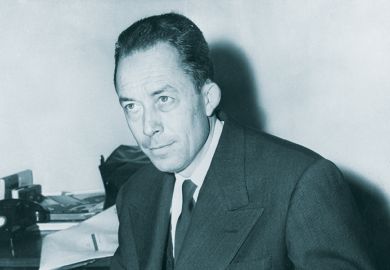When Mother Teresa of Calcutta died on September 5 1997, a few days after Princess Diana, a Calcutta daily carried the headline: "Numbed by Diana's death, Calcutta fails to mourn for Teresa". For two days her body remained in the room of her house while few people, poor or rich, came to pay their respects. But by the time that the worldwide order she founded, the Missionaries of Charity, had moved her remains to St Thomas' Church in central Calcutta and put her body on view in a glass box, India had decided on a state funeral for its Nobel peace prize laureate. Foreign dignitaries, including Hillary Clinton, US senators and congressmen and Vatican representatives, as well as India's prime minister, state governors and other celebrities came to her funeral. Teresa's body was carried on a gun carriage through Calcutta's streets to a ceremony at an indoor stadium before 6,000 invited guests, most of whom were nuns, clerics and Indian and foreign officials; only about 100 poor people attended. Despite her wish to be buried in the grounds of her church, the city's Catholic establishment decided to bury her in Mother House, apparently for fear of desecration of the grave. Today it is mostly foreign tourists who visit her grave. Her halo has considerably faded since her death, though the pope seems determined to make her a saint.
The western media, beginning with Malcolm Muggeridge's starry-eyed BBC television programme in 1968, built Teresa up as the world's kindest and most honourable soul - overlooking the fact that her mission in life, unlike Gandhi's, was more to promote religion than to improve the lot of the poor. Her call to thousands of pregnant Bangladeshi women raped by Pakistani soldiers during the liberation war in East Bengal to have their babies was definitely prompted by her Catholic faith. But she never said a word against the widespread abortion of female foetuses practised in India because she knew that to speak out would damage the Missionaries of Charity in India. When in 1980 one of her order's homes in north London caught fire as a result of insufficient precautions, nine women burnt to death. But such was the aura of its reputation in the West that there was no proper investigation into the incident.
During the 1990s, Aroup Chatterjee, a self-proclaimed atheist, began a crusade to expose Mother Teresa. Chatterjee, who was born and educated in Calcutta, is a doctor who now lives and works in Britain. In 1994 he prompted Channel 4 to probe Teresa's reputation, and the result was the controversial television documentary, Hell's Angel , presented by Christopher Hitchens, who subsequently published a polemic against her, The Missionary Position . Chatterjee's Mother Teresa: The Final Verdict is the product of his decade-long research into the Mother Teresa phenomenon.
From the evidence he documents, it is clear that Teresa often deliberately misled journalists with spurious statistics about her charitable work. Even in her Nobel acceptance speech in 1979, she falsely claimed to have picked up 36,000 destitutes from the streets of Calcutta, knowing that no western journalist would attempt to verify the statement of a pious and fragile nun. According to Chatterjee's estimate, the real figure is between 500 and 700 destitutes for the entire period of her operation in Calcutta since the 1930s, during which time there were a number of catastrophic natural and political disasters, such as the famine of 1943-44, the partition of Bengal in 1947 and the refugee influx from East Pakistan in 1971. The fact is that the Missionaries of Charity generally do not pick up the destitutes, they refer them to Calcutta Corporation's ambulance service. Only when no city hospital will take the dying are they brought to the Missionaries of Charity. Mostly, the order's ambulances are used as taxis by the nuns.
The special friendship between Teresa and Pope John Paul II naturally receives much attention in the book. They were bound together by their stance against contraception and abortion. Teresa also supported the pope's opposition to women priests and was regarded as "an honorary man by the Vatican inner circle". She became the Vatican's ideal missionary to the Islamic world and the Communist bloc by promoting "spiritual work" for the poor, travelling to Libya and Iraq, opening a convent in Tunis, and even working for her order in Cuba and Moscow. As she gleefully told an interviewer: "Castro asked me, 'Why do you want to come to Cuba?' As you know the church was completely closed then - no priests, no nuns. We have five houses there now. In Russia we have ten houses." Her lifelong regret was that she could not open an institution in China.
Her order had limited success in South America because she did not approve of "liberation theology" and priests who involved themselves in community work in opposition to dictatorial governments. Neither she nor the pope openly condemned the 1980 killing by a CIA-sponsored death squad of Archbishop Romero of El Salvador while he was conducting mass.
The chapter on Mother Teresa's financial affairs is disconcerting. Her order has never properly disclosed its income except in Britain. In 1981 it was due to be investigated following a Vatican money-laundering scandal but for mysterious reasons the investigation stalled. Chatterjee favours reopening it and maintains that Mother Teresa kept her accounts secret because most charitable donations went to religious activity. In the most notorious episode, the money she received from Charles Keating, who was then convicted and imprisoned for fraud in the Savings and Loan scandal, was never returned despite an official request to her from the deputy district attorney of Los Angeles County. Certainly, many donations were not spent on the poor of Calcutta as Mother Teresa would have the outside world believe; they were deposited in the Vatican Bank. If they had been, why did the medical facilities in her home for destitutes remain so rudimentary?
As someone, like Chatterjee, born and brought up in Calcutta and now living in Britain, I can vouch for Calcutta's limited relationship with Teresa.
She hardly connected herself with the city she lived in for more than six decades - and completely neglected its cultural and intellectual life. She knew very little Bengali and had little contact with the masses, though she was friendly with the city's charity-giving rich and influential. I became aware of her celebrity status only when I moved to England in the late 1960s. On a visit to Calcutta much later, I noticed that in her tiny home for the dying in Kalighat, which thrived on designer gloom, the patients were identified by serial numbers and were not allowed to walk about. Nor were they given intelligent medical attention or care - just a plastic-covered mattress and a frugal meal of rice and lentils. When their final hour came, the nuns, who came mainly from impoverished Bihar and spoke very basic Bengali, secretly converted the dying to Catholicism by promising eternal life. But if Teresa deprived her departing souls of medical support, she never denied herself the city's best medical treatment, offered for free, at the exclusive Woodlands Clinic and Birla Heart Institute.
In sum, Teresa used Calcutta's decaying environment to enhance her global image as "the saint of the gutters". No other city of India would have been as suitable for her teleology: that Calcutta's abject poverty was divinely ordained to prove the spiritual value of her mission. She knew that horrendous images from a city of bygone colonial wealth and power would make a strong impact on a guilty western psyche. Like Christ washing the feet of the poor, she would become an icon. The more sensitive Calcuttans were aware of her calumny but chose to remain quiet partly because she was marginal to the main life of the city and partly because they knew that their criticism would be ignored by the politically powerful (Indira Gandhi was among her admirers, as was Ronald Reagan). Even now very few in Calcutta openly criticise her, although the opposition is becoming stronger. The mayor's lobbying to name a street after Mother Teresa has yet to meet general approval.
Probably the Catholic church will eventually canonise her-despite the lack of a credible miracle required for beatification. As discussed by Chatterjee, the Vatican inner circle has tried to keep secret the identity of a miraculously cured illiterate tribal girl from a remote village.
Although sceptical Indian journalists discovered that the girl's tumour was cured by orthodox medical intervention, the Catholic hierarchy has ratified it as an "objective and organic miracle". The situation is somewhat reminiscent of the weapons of mass destruction in Iraq, which await ambiguous discovery. This necessary, well-documented book - which could have been improved with editing - is further testimony to much of the western world's, and especially the present US's, cultural, moral and religious insensitivity towards the rest of the globe.
Krishna Dutta is the author of Calcutta: A Cultural and Literary History .
Mother Teresa: The Final Verdict
Author - Aroup Chatterjee
ISBN - 81 88248 00 2 (www.meteorbooks.com)
Publisher - Meteor Books, Calcutta
Price - £9.99
Pages - 4
Register to continue
Why register?
- Registration is free and only takes a moment
- Once registered, you can read 3 articles a month
- Sign up for our newsletter
Subscribe
Or subscribe for unlimited access to:
- Unlimited access to news, views, insights & reviews
- Digital editions
- Digital access to THE’s university and college rankings analysis
Already registered or a current subscriber? Login



